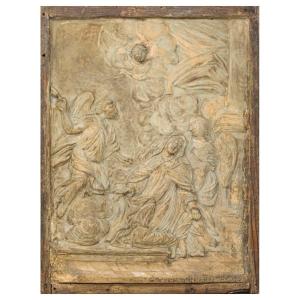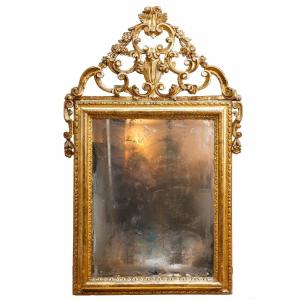Personification of the Day
Alabaster, cm 11,5 x 17,5 x 5
With base cm 14,5 x 20,8 x 11,7
Il Giorno is a marble sculpture (160x150 cm) that Michelangelo made between 1526 and 1531 in the New Sacristy in San Lorenzo in Florence. In particular it is one of the four allegories of the Parts of the Day, and is located to the right on the sarcophagus of the tomb of Giuliano de' Medici, Duke of Nemours.
Giuliano de' Medici, Duke of Nemours, the first figure of the Medici House to obtain a noble title, died in 1516 at the age of thirty-seven. Three years later his nephew Lorenzo, Duke of Urbino, also disappeared, extinguishing the legitimate lines of descent of the main branch of the family, to the great dismay of Pope Leo X (Giovanni de' Medici, brother and uncle of the two dukes, respectively)who had spent so much on the rise of his family. It was in these circumstances that the decision was made to entrust to Michelangelo the construction of a princely tomb for the two deceased offspring, to be inserted in the family church, San Lorenzo in Florence and which later took the name of New Sacristy. Having decided to make a twin environment to the oldest Old Sacristy of Brunelleschi, it was decided to bury in this new monumental shrine also the two "Magnifici", Lorenzo (m. 1492) and Giuliano (m. 1478), respectively father and uncle of the pope. The redesign of the New Sacristy began around 1519, and work began in 1521. After the interruption for the pope’s death, they resumed in 1524, when the artist, for the new Medici pontiff Clement VII, definitively established the architectural structure of the complex. Models for the tombs of the two "dukes" were prepared that year. The work lasted a long time and Michelangelo arrived at a solution with a smaller number of statues than planned: only three instead of five or seven.
The Day was probably begun in 1526, when the tomb of Lorenzo was finished and that of Giuliano started. The statue had to be completed after the resumption of work following the forced pause of the siege of Florence and its consequences, being left to a state of conspicuous "non-finito" at the departure of the artist for Rome in 1534. The Day is represented as a male personification, half-stretched and naked, like the other statues in the series. It had as model, perhaps, the river deities of the arch of Septimius Severus, the Torso of the Belvedere of which resumed the powerful anatomical structure in tension. He also resumed the pose of the Child in the youthful Madonna della Scala and that of one of the bronze nudes in the vault of the Sistine Chapel. It is the only one, among the series of allegories, to give its back to the viewer, in a pose opposite to that of the nearby Night. The left elbow is bent in support, while the right arm stretches backwards to look for something: only the forearm is actually sculpted, the hand is lost in the unmarked part. The legs are overlapped in the opposite direction to the rotation of the torso and this screwing is also evidenced by the rotation of the head towards the viewer. The bearded face, just rough-hewn, shows only a mysterious expression, highly evocative and emblematic because of its incompleteness. The work has received numerous interpretations: political symbol of rebellion from slavery, or autobiographical theme of the drive towards freedom; symbol of Christian light or personification of life; allegory of fire or temper collerico; personification of action, pain, anger, contempt or revenge.
The work in question is taken from the famous statue of Michelangelo and is located between the late eighteenth and early nineteenth century in the middle of the period of the Grand Tour during which the noble scions went to Italy to explore the beauty and build collections, Like those of the famous Charles Townley (1737-1805), who came to Italy four times, he accumulated an incredible amount of classical works including vases, bronzes and coins, to which was added a large library with manuscripts and prints. The artist follows the features of the statue without that sense of non-finto that pervades the work of Michelangelo, and fixes the plastic tension in a noble material such as alabaster, which gives the exemplary high quality and preciousness.
With Ars Antiqua it is possible to defer all amounts up to € 7,500 at ZERO RATE, for a total of 15 INSTALLMENTS.
Ex. Tot. € 4,500 = Monthly installment € 300 for 15 months.
Ex. Tot. € 3.600 = Monthly installment € 720 for 5 months.
For amounts exceeding € 7,500 or for longer periods of time (over 15 installments), we can provide a personalized payment.
Contact us directly to get the best quote.
LIVE
– SUNDAY 17.00 – 21.00 Dig.terr. 126 + 813 SKY
– In streaming on our website www.arsantiquasrl.com and on our social networks Facebook and Youtube
All the works proposed by Ars Antiqua are sold accompanied by a certificate of authenticity in accordance with the law and an accurate detailed information sheet.
It is possible to see the works directly at the gallery showroom in Milan, in via Pisacane 55 and 57.
We personally organize transport and deliveries of the works, both for Italy and abroad.








































 Le Magazine de PROANTIC
Le Magazine de PROANTIC TRÉSORS Magazine
TRÉSORS Magazine Rivista Artiquariato
Rivista Artiquariato